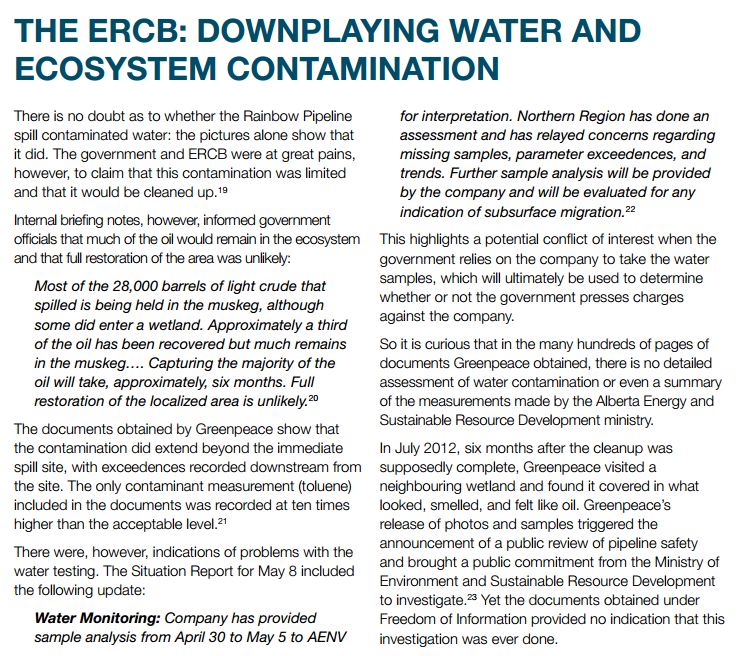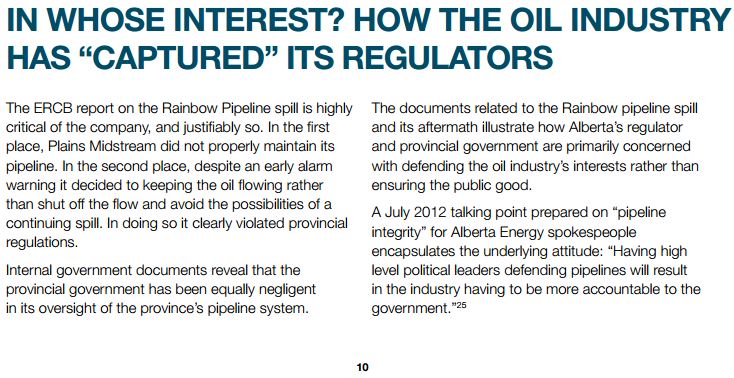The Rainbow Spill: A Case of Crime and (No) Punishment by Keith Stewart, April 24, 2013, Greenpeace.ca
The February 2013 findings of Alberta’s Energy Resources Conservation Board (ERCB) investigation into the April 2011 Rainbow Pipeline spill were damning. The cracks in the Rainbow pipeline that caused it to spill oil into the wetlands near the Lubicon Cree community of Little Buffalo should have been identified and repaired by the pipeline’s owner, Plains Midstream. The 28,000-barrel spill would have been much smaller if the company had not restarted the pipeline three times after the sounding of the first alarm indicating a leak.
The company violated a number of provincial regulations and failed miserably in its responsibility to communicate with local communities harmed by the spill. Yet despite these findings, neither the ERCB nor the provincial government pursued the available legal or financial sanctions against the company. Instead – as internal documents obtained by Greenpeace under the Freedom of Information and Privacy Act reveal – the prime concern of both the regulator and the Alberta government was not to protect the affected communities or the environment but to limit the damage to the oil industry’s public image.
Our specific findings include: … The ERCB investigation report and public statements from the government misrepresented the results of air-testing at Little Buffalo school, thereby providing a false reassurance on the issue of health impacts.
The ERCB downplayed the spread of spread of oil contamination in local wetlands. The government relied on the company to take the water samples that would ultimately be used in a court case against them. Confidential government reports indicate that there were problems (such as missing samples) with the water samples submitted by the company, which may be one of the reasons why no charges were brought forward. This response to the Rainbow pipeline spill is symptomatic of a more systemic problem: government agencies that have been ‘captured’ by the very same oil industry that they are supposed to regulate; as a result, they defend the interests of the industry over the public interest.
The Alberta government is in the process of establishing a new regulatory agency to oversee the oil and gas industry. The government’s current plan will further entrench this regulator as a defender of the industry rather than of the public interest. Greenpeace recommends that the government take the opportunity offered by the establishment of this new agency to:
1. Increase transparency through greater access to information.
2. Implement greater public involvement in decision making, as a counterweight to the influence of the oil industry.
3. Put an end to the revolving door between industry lobby groups and the leadership of regulatory agencies.
A first step in this direction would be to revisit the decision to appoint oil industry insider Gerry Protti as the head of the new regulatory agency.
…
The ERCB: Downplaying Water and Ecosystem Contamination
…
This highlights a potential conflict of interest when the government relies on the company to take the water samples, which will ultimately be used to determine whether or not the government presses charges against the company.
…
What the Energy Minister’s May 6, 2011 Briefing Note said
“Results from May 2 sampling indicate there are some exceedances of hydrocarbons downstream from the wetlands. Exceedences of toluene (.0227 mg/litre) have been recorded in the area of the wetland. The water quality objective for toluene is .002 mg/litre for fresh water. Toluene is non carcinogenic. [Emphasis added]
[Refer also to:
Chemicals in the Environment: Toluene (CAS NO. 108-88-3) by Office of Pollution Prevention and Toxics August 1994, U.S. Environmental Protection Agency
Toluene (also called methyl benzene) is a colorless, flammable liquid. It occurs naturally in petroleum crude oil. Petroleum crude oil is by far the largest source of toluene.
…
Because it is a liquid that does not bind well to soil, toluene that makes its way into the ground can move through the ground and enter groundwater.
…
Effects of toluene on human health and the environment depend on how much toluene is present and the length and frequency of exposure. Effects also depend on the health of a person or the condition of the environment when exposure occurs. Breathing large amounts of toluene for short periods of time adversely affects the human nervous system, the kidneys, the liver, and the heart. Effects range from unsteadiness and tingling in fingers and toes to unconsciousness and death. Direct, prolonged contact with toluene liquid or vapor irritates the skin and the eyes. These effects are not likely to occur at levels of toluene that are normally found in the environment.
…
Human health effects associated with breathing or otherwise consuming smaller amounts of toluene over long periods of time are not known. Repeatedly breathing large amounts of toluene, such as when “sniffing” glue or paint, can cause permanent brain damage. As a result, humans can develop problems with speech, hearing, and vision. Humans can also experience loss of muscle control, loss of memory, and decreased mental
ability. Exposure to toluene can also adversely affect the kidneys. Laboratory animal studies and, in some cases, human exposure studies show that repeat exposure to large amounts of toluene during pregnancy can adversely affect the developing fetus. [Emphasis added]


